Jurisdictions and Protection of Indigenous People Rights in Australia
VerifiedAdded on 2022/11/28
|14
|2756
|330
Report
AI Summary
This report provides a comprehensive analysis of the rights and protections afforded to Indigenous people in Australia. It begins by defining Indigenous people and highlighting the challenges they face, including social justice issues, cultural preservation, and self-determination. The report examines the legal frameworks in place, including the Native Title Act and the government's initiatives in mental health and social well-being, and compares Australia's approach with those of New Zealand, Canada, and other nations, focusing on treaties, constitutional recognition, and representation in government. The report also discusses the landmark case of Mabo v. Queensland and analyzes the steps taken by the Australian government to address Indigenous mental health, including funding and integrated mental health services. The report stresses the importance of recognizing Indigenous rights, promoting cultural responsiveness, and ensuring equitable treatment, providing a detailed overview of the legal, social, and political aspects of Indigenous rights and protection in Australia.
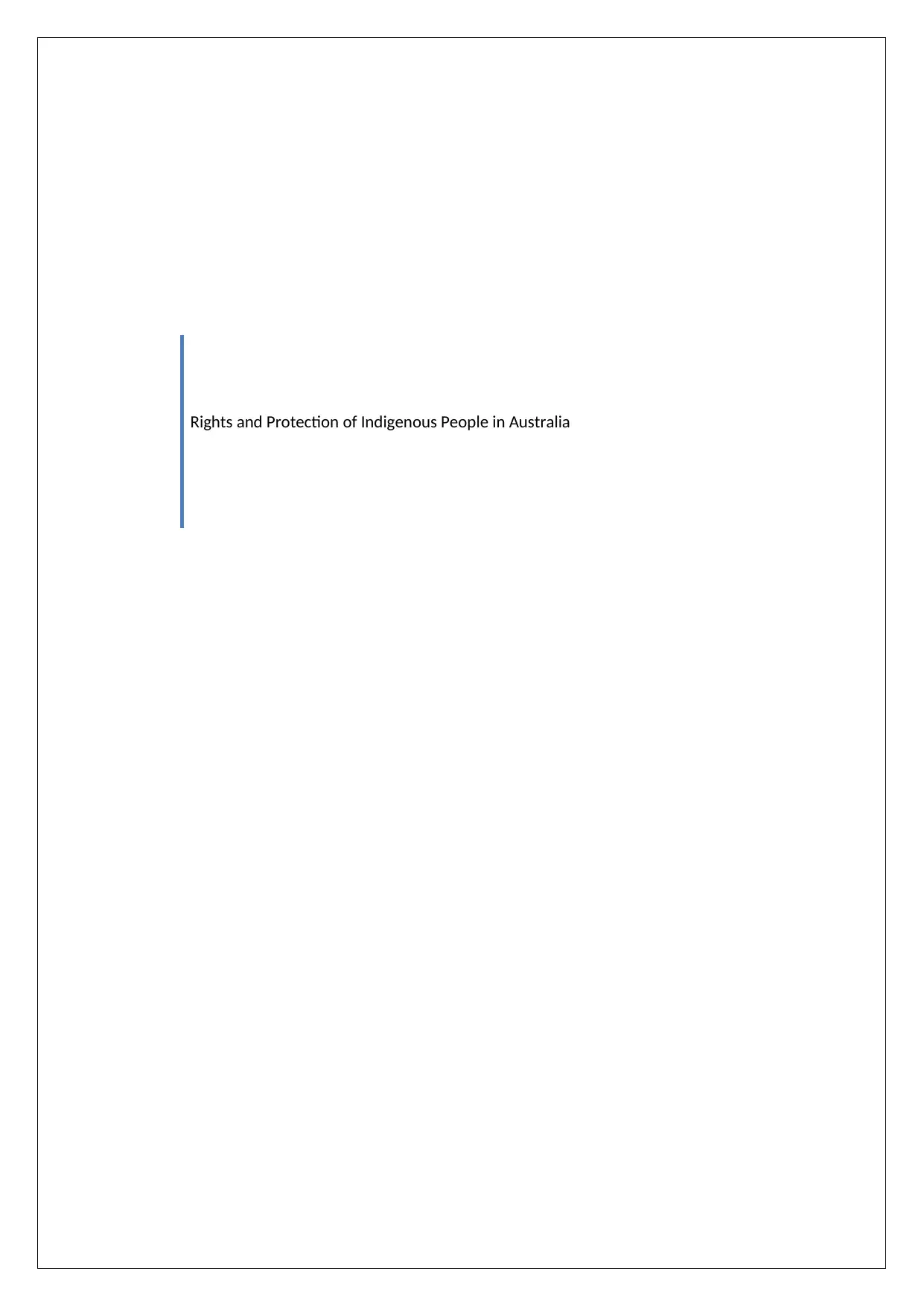
Rights and Protection of Indigenous People in Australia
Paraphrase This Document
Need a fresh take? Get an instant paraphrase of this document with our AI Paraphraser
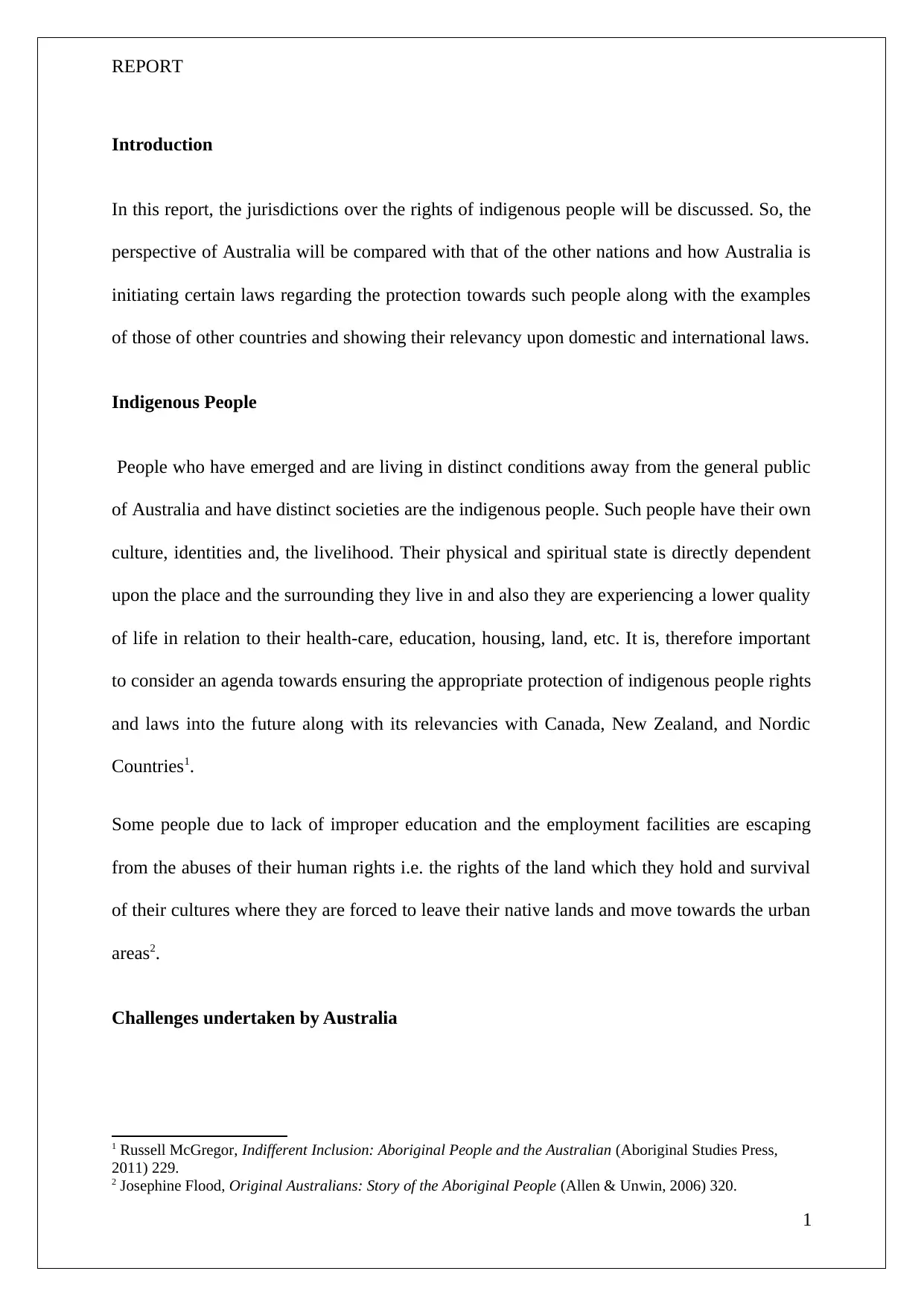
REPORT
Introduction
In this report, the jurisdictions over the rights of indigenous people will be discussed. So, the
perspective of Australia will be compared with that of the other nations and how Australia is
initiating certain laws regarding the protection towards such people along with the examples
of those of other countries and showing their relevancy upon domestic and international laws.
Indigenous People
People who have emerged and are living in distinct conditions away from the general public
of Australia and have distinct societies are the indigenous people. Such people have their own
culture, identities and, the livelihood. Their physical and spiritual state is directly dependent
upon the place and the surrounding they live in and also they are experiencing a lower quality
of life in relation to their health-care, education, housing, land, etc. It is, therefore important
to consider an agenda towards ensuring the appropriate protection of indigenous people rights
and laws into the future along with its relevancies with Canada, New Zealand, and Nordic
Countries1.
Some people due to lack of improper education and the employment facilities are escaping
from the abuses of their human rights i.e. the rights of the land which they hold and survival
of their cultures where they are forced to leave their native lands and move towards the urban
areas2.
Challenges undertaken by Australia
1 Russell McGregor, Indifferent Inclusion: Aboriginal People and the Australian (Aboriginal Studies Press,
2011) 229.
2 Josephine Flood, Original Australians: Story of the Aboriginal People (Allen & Unwin, 2006) 320.
1
Introduction
In this report, the jurisdictions over the rights of indigenous people will be discussed. So, the
perspective of Australia will be compared with that of the other nations and how Australia is
initiating certain laws regarding the protection towards such people along with the examples
of those of other countries and showing their relevancy upon domestic and international laws.
Indigenous People
People who have emerged and are living in distinct conditions away from the general public
of Australia and have distinct societies are the indigenous people. Such people have their own
culture, identities and, the livelihood. Their physical and spiritual state is directly dependent
upon the place and the surrounding they live in and also they are experiencing a lower quality
of life in relation to their health-care, education, housing, land, etc. It is, therefore important
to consider an agenda towards ensuring the appropriate protection of indigenous people rights
and laws into the future along with its relevancies with Canada, New Zealand, and Nordic
Countries1.
Some people due to lack of improper education and the employment facilities are escaping
from the abuses of their human rights i.e. the rights of the land which they hold and survival
of their cultures where they are forced to leave their native lands and move towards the urban
areas2.
Challenges undertaken by Australia
1 Russell McGregor, Indifferent Inclusion: Aboriginal People and the Australian (Aboriginal Studies Press,
2011) 229.
2 Josephine Flood, Original Australians: Story of the Aboriginal People (Allen & Unwin, 2006) 320.
1
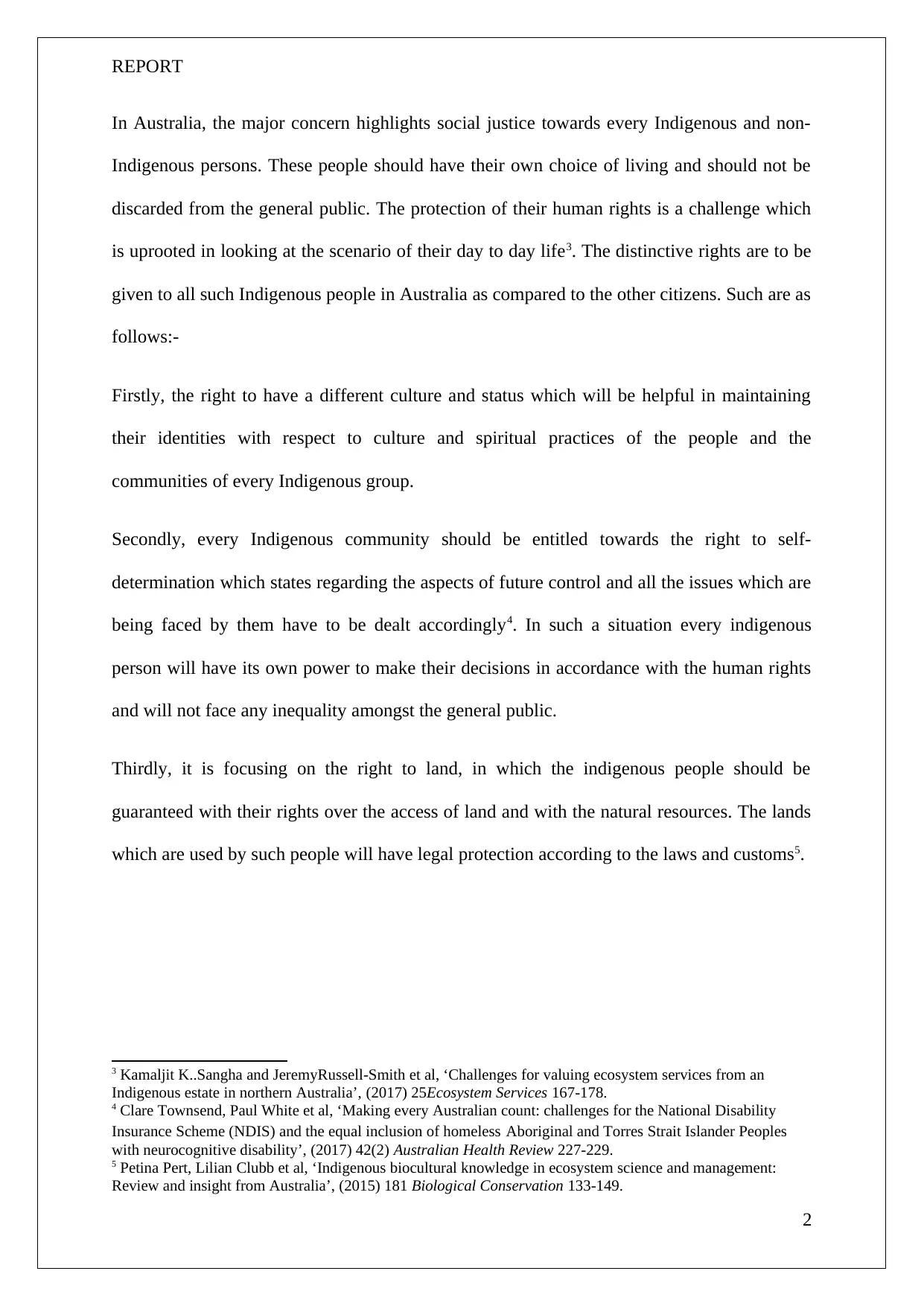
REPORT
In Australia, the major concern highlights social justice towards every Indigenous and non-
Indigenous persons. These people should have their own choice of living and should not be
discarded from the general public. The protection of their human rights is a challenge which
is uprooted in looking at the scenario of their day to day life3. The distinctive rights are to be
given to all such Indigenous people in Australia as compared to the other citizens. Such are as
follows:-
Firstly, the right to have a different culture and status which will be helpful in maintaining
their identities with respect to culture and spiritual practices of the people and the
communities of every Indigenous group.
Secondly, every Indigenous community should be entitled towards the right to self-
determination which states regarding the aspects of future control and all the issues which are
being faced by them have to be dealt accordingly4. In such a situation every indigenous
person will have its own power to make their decisions in accordance with the human rights
and will not face any inequality amongst the general public.
Thirdly, it is focusing on the right to land, in which the indigenous people should be
guaranteed with their rights over the access of land and with the natural resources. The lands
which are used by such people will have legal protection according to the laws and customs5.
3 Kamaljit K..Sangha and JeremyRussell-Smith et al, ‘Challenges for valuing ecosystem services from an
Indigenous estate in northern Australia’, (2017) 25Ecosystem Services 167-178.
4 Clare Townsend, Paul White et al, ‘Making every Australian count: challenges for the National Disability
Insurance Scheme (NDIS) and the equal inclusion of homeless Aboriginal and Torres Strait Islander Peoples
with neurocognitive disability’, (2017) 42(2) Australian Health Review 227-229.
5 Petina Pert, Lilian Clubb et al, ‘Indigenous biocultural knowledge in ecosystem science and management:
Review and insight from Australia’, (2015) 181 Biological Conservation 133-149.
2
In Australia, the major concern highlights social justice towards every Indigenous and non-
Indigenous persons. These people should have their own choice of living and should not be
discarded from the general public. The protection of their human rights is a challenge which
is uprooted in looking at the scenario of their day to day life3. The distinctive rights are to be
given to all such Indigenous people in Australia as compared to the other citizens. Such are as
follows:-
Firstly, the right to have a different culture and status which will be helpful in maintaining
their identities with respect to culture and spiritual practices of the people and the
communities of every Indigenous group.
Secondly, every Indigenous community should be entitled towards the right to self-
determination which states regarding the aspects of future control and all the issues which are
being faced by them have to be dealt accordingly4. In such a situation every indigenous
person will have its own power to make their decisions in accordance with the human rights
and will not face any inequality amongst the general public.
Thirdly, it is focusing on the right to land, in which the indigenous people should be
guaranteed with their rights over the access of land and with the natural resources. The lands
which are used by such people will have legal protection according to the laws and customs5.
3 Kamaljit K..Sangha and JeremyRussell-Smith et al, ‘Challenges for valuing ecosystem services from an
Indigenous estate in northern Australia’, (2017) 25Ecosystem Services 167-178.
4 Clare Townsend, Paul White et al, ‘Making every Australian count: challenges for the National Disability
Insurance Scheme (NDIS) and the equal inclusion of homeless Aboriginal and Torres Strait Islander Peoples
with neurocognitive disability’, (2017) 42(2) Australian Health Review 227-229.
5 Petina Pert, Lilian Clubb et al, ‘Indigenous biocultural knowledge in ecosystem science and management:
Review and insight from Australia’, (2015) 181 Biological Conservation 133-149.
2
⊘ This is a preview!⊘
Do you want full access?
Subscribe today to unlock all pages.

Trusted by 1+ million students worldwide
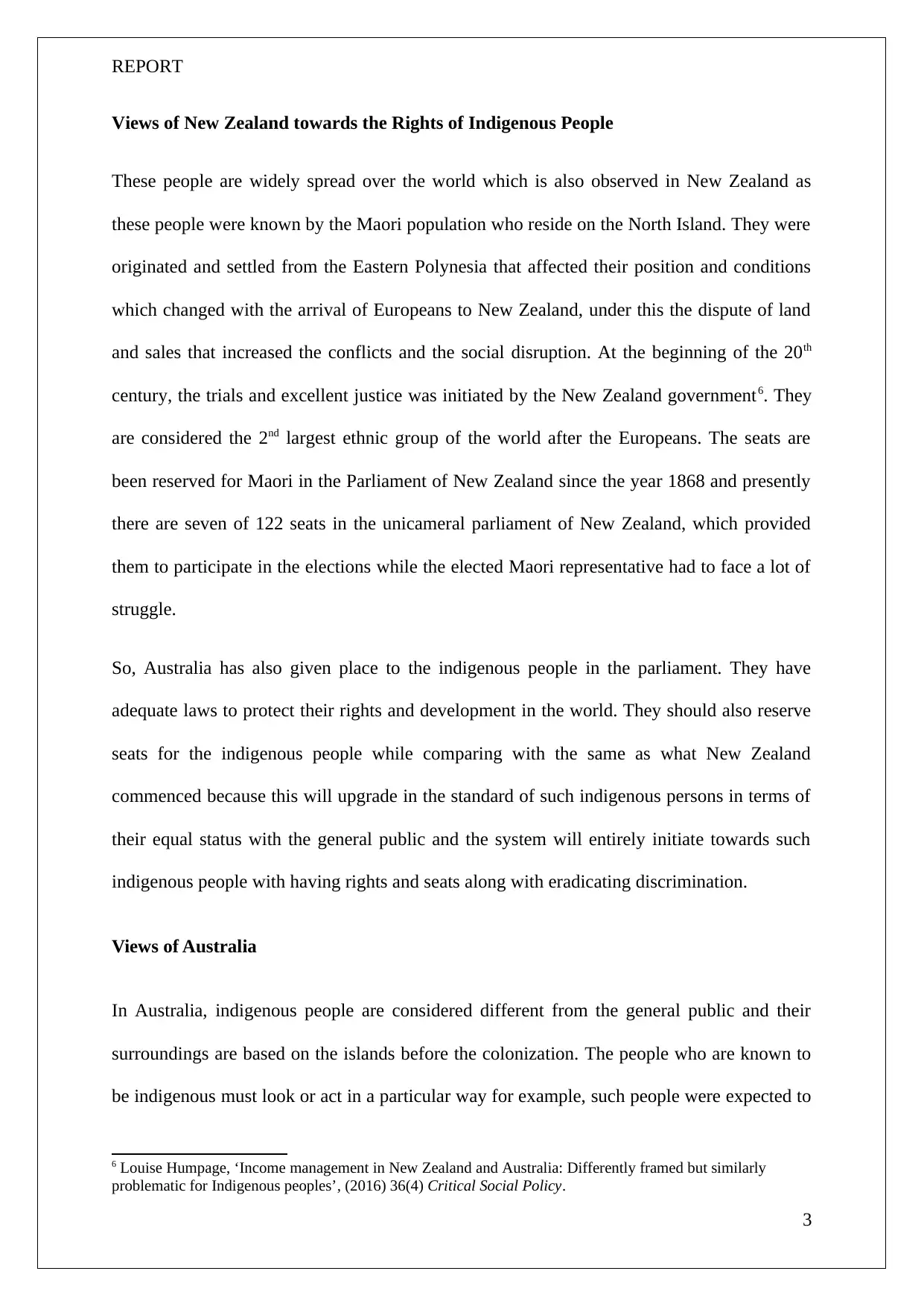
REPORT
Views of New Zealand towards the Rights of Indigenous People
These people are widely spread over the world which is also observed in New Zealand as
these people were known by the Maori population who reside on the North Island. They were
originated and settled from the Eastern Polynesia that affected their position and conditions
which changed with the arrival of Europeans to New Zealand, under this the dispute of land
and sales that increased the conflicts and the social disruption. At the beginning of the 20th
century, the trials and excellent justice was initiated by the New Zealand government6. They
are considered the 2nd largest ethnic group of the world after the Europeans. The seats are
been reserved for Maori in the Parliament of New Zealand since the year 1868 and presently
there are seven of 122 seats in the unicameral parliament of New Zealand, which provided
them to participate in the elections while the elected Maori representative had to face a lot of
struggle.
So, Australia has also given place to the indigenous people in the parliament. They have
adequate laws to protect their rights and development in the world. They should also reserve
seats for the indigenous people while comparing with the same as what New Zealand
commenced because this will upgrade in the standard of such indigenous persons in terms of
their equal status with the general public and the system will entirely initiate towards such
indigenous people with having rights and seats along with eradicating discrimination.
Views of Australia
In Australia, indigenous people are considered different from the general public and their
surroundings are based on the islands before the colonization. The people who are known to
be indigenous must look or act in a particular way for example, such people were expected to
6 Louise Humpage, ‘Income management in New Zealand and Australia: Differently framed but similarly
problematic for Indigenous peoples’, (2016) 36(4) Critical Social Policy.
3
Views of New Zealand towards the Rights of Indigenous People
These people are widely spread over the world which is also observed in New Zealand as
these people were known by the Maori population who reside on the North Island. They were
originated and settled from the Eastern Polynesia that affected their position and conditions
which changed with the arrival of Europeans to New Zealand, under this the dispute of land
and sales that increased the conflicts and the social disruption. At the beginning of the 20th
century, the trials and excellent justice was initiated by the New Zealand government6. They
are considered the 2nd largest ethnic group of the world after the Europeans. The seats are
been reserved for Maori in the Parliament of New Zealand since the year 1868 and presently
there are seven of 122 seats in the unicameral parliament of New Zealand, which provided
them to participate in the elections while the elected Maori representative had to face a lot of
struggle.
So, Australia has also given place to the indigenous people in the parliament. They have
adequate laws to protect their rights and development in the world. They should also reserve
seats for the indigenous people while comparing with the same as what New Zealand
commenced because this will upgrade in the standard of such indigenous persons in terms of
their equal status with the general public and the system will entirely initiate towards such
indigenous people with having rights and seats along with eradicating discrimination.
Views of Australia
In Australia, indigenous people are considered different from the general public and their
surroundings are based on the islands before the colonization. The people who are known to
be indigenous must look or act in a particular way for example, such people were expected to
6 Louise Humpage, ‘Income management in New Zealand and Australia: Differently framed but similarly
problematic for Indigenous peoples’, (2016) 36(4) Critical Social Policy.
3
Paraphrase This Document
Need a fresh take? Get an instant paraphrase of this document with our AI Paraphraser
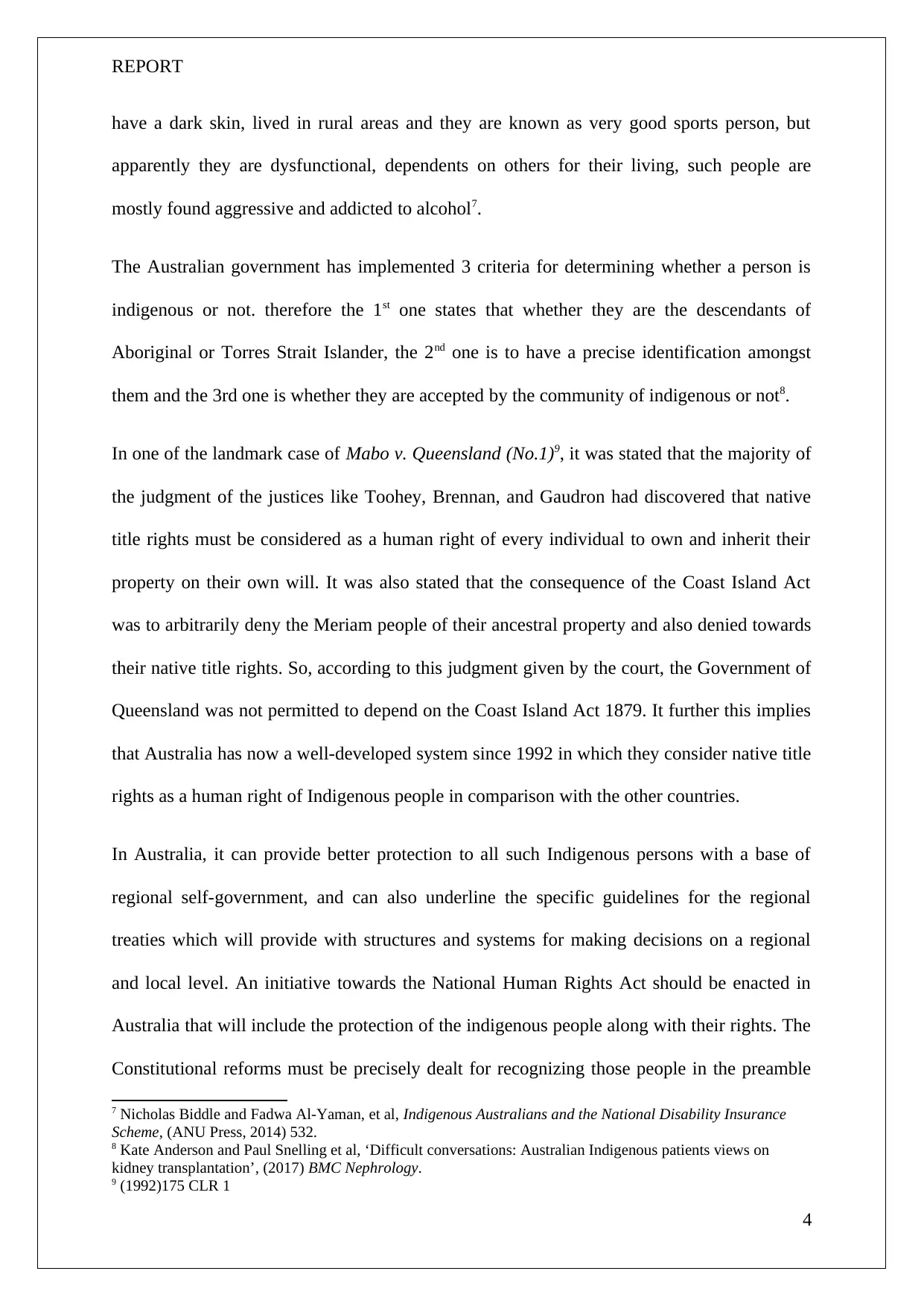
REPORT
have a dark skin, lived in rural areas and they are known as very good sports person, but
apparently they are dysfunctional, dependents on others for their living, such people are
mostly found aggressive and addicted to alcohol7.
The Australian government has implemented 3 criteria for determining whether a person is
indigenous or not. therefore the 1st one states that whether they are the descendants of
Aboriginal or Torres Strait Islander, the 2nd one is to have a precise identification amongst
them and the 3rd one is whether they are accepted by the community of indigenous or not8.
In one of the landmark case of Mabo v. Queensland (No.1)9, it was stated that the majority of
the judgment of the justices like Toohey, Brennan, and Gaudron had discovered that native
title rights must be considered as a human right of every individual to own and inherit their
property on their own will. It was also stated that the consequence of the Coast Island Act
was to arbitrarily deny the Meriam people of their ancestral property and also denied towards
their native title rights. So, according to this judgment given by the court, the Government of
Queensland was not permitted to depend on the Coast Island Act 1879. It further this implies
that Australia has now a well-developed system since 1992 in which they consider native title
rights as a human right of Indigenous people in comparison with the other countries.
In Australia, it can provide better protection to all such Indigenous persons with a base of
regional self-government, and can also underline the specific guidelines for the regional
treaties which will provide with structures and systems for making decisions on a regional
and local level. An initiative towards the National Human Rights Act should be enacted in
Australia that will include the protection of the indigenous people along with their rights. The
Constitutional reforms must be precisely dealt for recognizing those people in the preamble
7 Nicholas Biddle and Fadwa Al-Yaman, et al, Indigenous Australians and the National Disability Insurance
Scheme, (ANU Press, 2014) 532.
8 Kate Anderson and Paul Snelling et al, ‘Difficult conversations: Australian Indigenous patients views on
kidney transplantation’, (2017) BMC Nephrology.
9 (1992)175 CLR 1
4
have a dark skin, lived in rural areas and they are known as very good sports person, but
apparently they are dysfunctional, dependents on others for their living, such people are
mostly found aggressive and addicted to alcohol7.
The Australian government has implemented 3 criteria for determining whether a person is
indigenous or not. therefore the 1st one states that whether they are the descendants of
Aboriginal or Torres Strait Islander, the 2nd one is to have a precise identification amongst
them and the 3rd one is whether they are accepted by the community of indigenous or not8.
In one of the landmark case of Mabo v. Queensland (No.1)9, it was stated that the majority of
the judgment of the justices like Toohey, Brennan, and Gaudron had discovered that native
title rights must be considered as a human right of every individual to own and inherit their
property on their own will. It was also stated that the consequence of the Coast Island Act
was to arbitrarily deny the Meriam people of their ancestral property and also denied towards
their native title rights. So, according to this judgment given by the court, the Government of
Queensland was not permitted to depend on the Coast Island Act 1879. It further this implies
that Australia has now a well-developed system since 1992 in which they consider native title
rights as a human right of Indigenous people in comparison with the other countries.
In Australia, it can provide better protection to all such Indigenous persons with a base of
regional self-government, and can also underline the specific guidelines for the regional
treaties which will provide with structures and systems for making decisions on a regional
and local level. An initiative towards the National Human Rights Act should be enacted in
Australia that will include the protection of the indigenous people along with their rights. The
Constitutional reforms must be precisely dealt for recognizing those people in the preamble
7 Nicholas Biddle and Fadwa Al-Yaman, et al, Indigenous Australians and the National Disability Insurance
Scheme, (ANU Press, 2014) 532.
8 Kate Anderson and Paul Snelling et al, ‘Difficult conversations: Australian Indigenous patients views on
kidney transplantation’, (2017) BMC Nephrology.
9 (1992)175 CLR 1
4
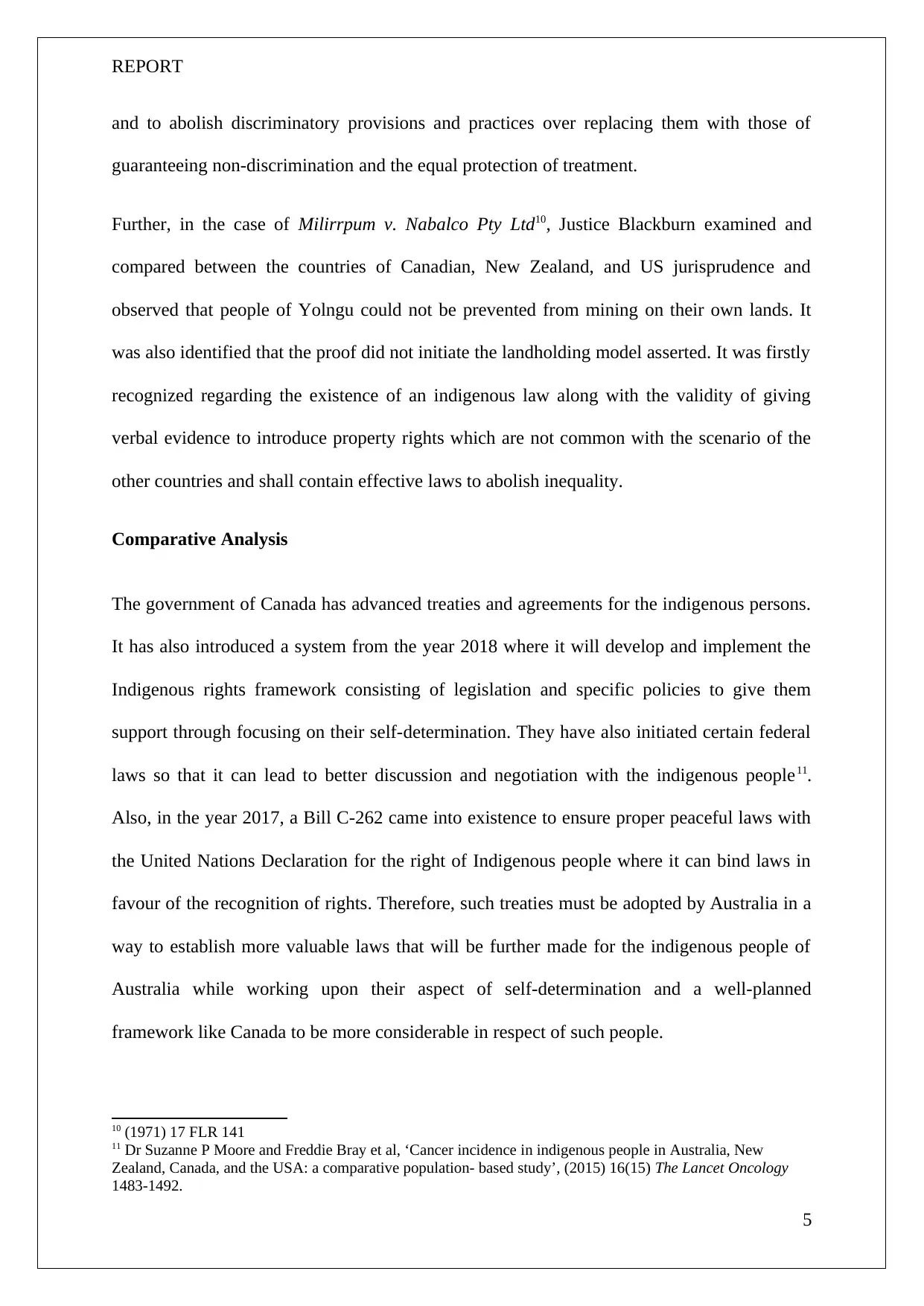
REPORT
and to abolish discriminatory provisions and practices over replacing them with those of
guaranteeing non-discrimination and the equal protection of treatment.
Further, in the case of Milirrpum v. Nabalco Pty Ltd10, Justice Blackburn examined and
compared between the countries of Canadian, New Zealand, and US jurisprudence and
observed that people of Yolngu could not be prevented from mining on their own lands. It
was also identified that the proof did not initiate the landholding model asserted. It was firstly
recognized regarding the existence of an indigenous law along with the validity of giving
verbal evidence to introduce property rights which are not common with the scenario of the
other countries and shall contain effective laws to abolish inequality.
Comparative Analysis
The government of Canada has advanced treaties and agreements for the indigenous persons.
It has also introduced a system from the year 2018 where it will develop and implement the
Indigenous rights framework consisting of legislation and specific policies to give them
support through focusing on their self-determination. They have also initiated certain federal
laws so that it can lead to better discussion and negotiation with the indigenous people11.
Also, in the year 2017, a Bill C-262 came into existence to ensure proper peaceful laws with
the United Nations Declaration for the right of Indigenous people where it can bind laws in
favour of the recognition of rights. Therefore, such treaties must be adopted by Australia in a
way to establish more valuable laws that will be further made for the indigenous people of
Australia while working upon their aspect of self-determination and a well-planned
framework like Canada to be more considerable in respect of such people.
10 (1971) 17 FLR 141
11 Dr Suzanne P Moore and Freddie Bray et al, ‘Cancer incidence in indigenous people in Australia, New
Zealand, Canada, and the USA: a comparative population- based study’, (2015) 16(15) The Lancet Oncology
1483-1492.
5
and to abolish discriminatory provisions and practices over replacing them with those of
guaranteeing non-discrimination and the equal protection of treatment.
Further, in the case of Milirrpum v. Nabalco Pty Ltd10, Justice Blackburn examined and
compared between the countries of Canadian, New Zealand, and US jurisprudence and
observed that people of Yolngu could not be prevented from mining on their own lands. It
was also identified that the proof did not initiate the landholding model asserted. It was firstly
recognized regarding the existence of an indigenous law along with the validity of giving
verbal evidence to introduce property rights which are not common with the scenario of the
other countries and shall contain effective laws to abolish inequality.
Comparative Analysis
The government of Canada has advanced treaties and agreements for the indigenous persons.
It has also introduced a system from the year 2018 where it will develop and implement the
Indigenous rights framework consisting of legislation and specific policies to give them
support through focusing on their self-determination. They have also initiated certain federal
laws so that it can lead to better discussion and negotiation with the indigenous people11.
Also, in the year 2017, a Bill C-262 came into existence to ensure proper peaceful laws with
the United Nations Declaration for the right of Indigenous people where it can bind laws in
favour of the recognition of rights. Therefore, such treaties must be adopted by Australia in a
way to establish more valuable laws that will be further made for the indigenous people of
Australia while working upon their aspect of self-determination and a well-planned
framework like Canada to be more considerable in respect of such people.
10 (1971) 17 FLR 141
11 Dr Suzanne P Moore and Freddie Bray et al, ‘Cancer incidence in indigenous people in Australia, New
Zealand, Canada, and the USA: a comparative population- based study’, (2015) 16(15) The Lancet Oncology
1483-1492.
5
⊘ This is a preview!⊘
Do you want full access?
Subscribe today to unlock all pages.

Trusted by 1+ million students worldwide
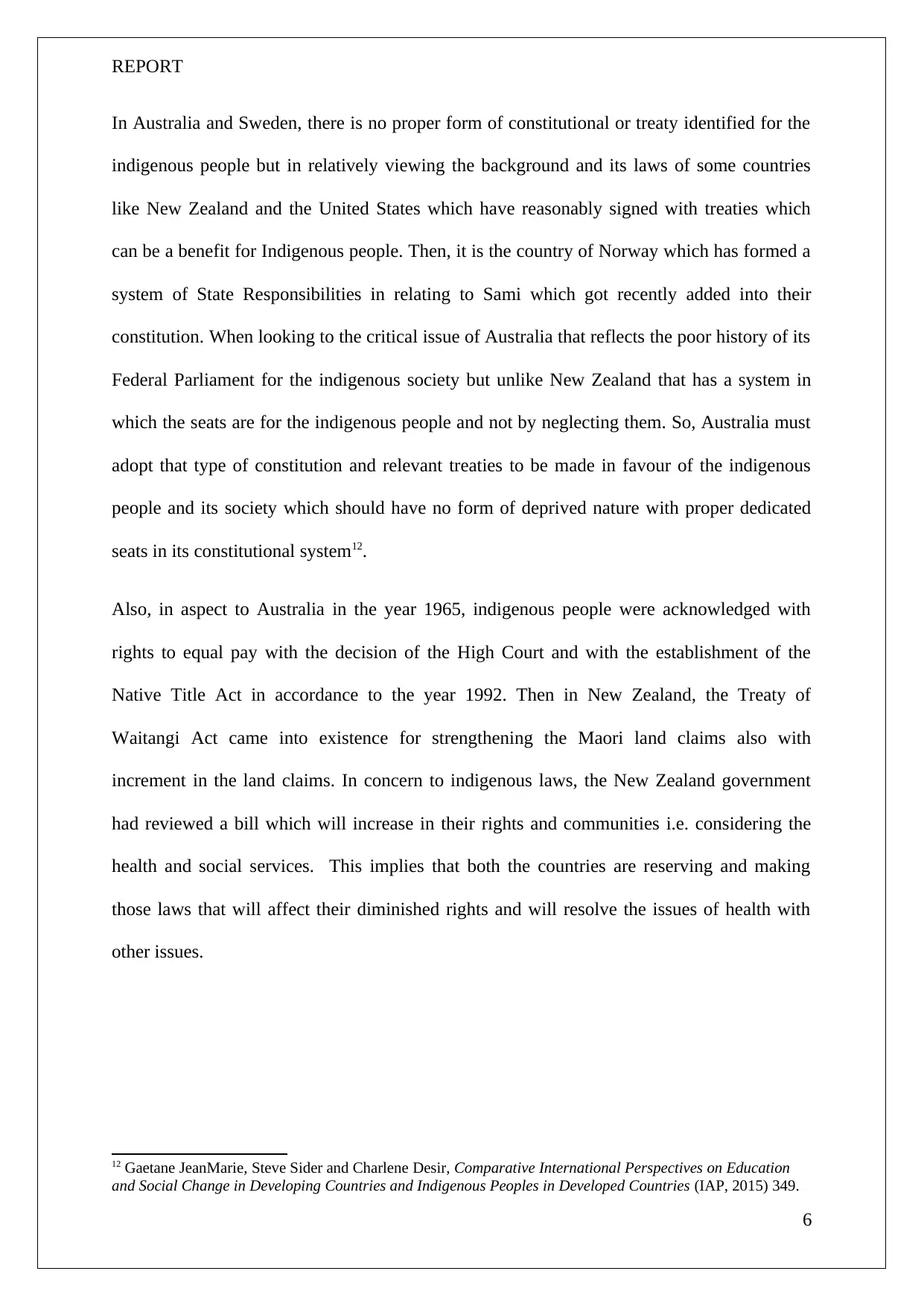
REPORT
In Australia and Sweden, there is no proper form of constitutional or treaty identified for the
indigenous people but in relatively viewing the background and its laws of some countries
like New Zealand and the United States which have reasonably signed with treaties which
can be a benefit for Indigenous people. Then, it is the country of Norway which has formed a
system of State Responsibilities in relating to Sami which got recently added into their
constitution. When looking to the critical issue of Australia that reflects the poor history of its
Federal Parliament for the indigenous society but unlike New Zealand that has a system in
which the seats are for the indigenous people and not by neglecting them. So, Australia must
adopt that type of constitution and relevant treaties to be made in favour of the indigenous
people and its society which should have no form of deprived nature with proper dedicated
seats in its constitutional system12.
Also, in aspect to Australia in the year 1965, indigenous people were acknowledged with
rights to equal pay with the decision of the High Court and with the establishment of the
Native Title Act in accordance to the year 1992. Then in New Zealand, the Treaty of
Waitangi Act came into existence for strengthening the Maori land claims also with
increment in the land claims. In concern to indigenous laws, the New Zealand government
had reviewed a bill which will increase in their rights and communities i.e. considering the
health and social services. This implies that both the countries are reserving and making
those laws that will affect their diminished rights and will resolve the issues of health with
other issues.
12 Gaetane JeanMarie, Steve Sider and Charlene Desir, Comparative International Perspectives on Education
and Social Change in Developing Countries and Indigenous Peoples in Developed Countries (IAP, 2015) 349.
6
In Australia and Sweden, there is no proper form of constitutional or treaty identified for the
indigenous people but in relatively viewing the background and its laws of some countries
like New Zealand and the United States which have reasonably signed with treaties which
can be a benefit for Indigenous people. Then, it is the country of Norway which has formed a
system of State Responsibilities in relating to Sami which got recently added into their
constitution. When looking to the critical issue of Australia that reflects the poor history of its
Federal Parliament for the indigenous society but unlike New Zealand that has a system in
which the seats are for the indigenous people and not by neglecting them. So, Australia must
adopt that type of constitution and relevant treaties to be made in favour of the indigenous
people and its society which should have no form of deprived nature with proper dedicated
seats in its constitutional system12.
Also, in aspect to Australia in the year 1965, indigenous people were acknowledged with
rights to equal pay with the decision of the High Court and with the establishment of the
Native Title Act in accordance to the year 1992. Then in New Zealand, the Treaty of
Waitangi Act came into existence for strengthening the Maori land claims also with
increment in the land claims. In concern to indigenous laws, the New Zealand government
had reviewed a bill which will increase in their rights and communities i.e. considering the
health and social services. This implies that both the countries are reserving and making
those laws that will affect their diminished rights and will resolve the issues of health with
other issues.
12 Gaetane JeanMarie, Steve Sider and Charlene Desir, Comparative International Perspectives on Education
and Social Change in Developing Countries and Indigenous Peoples in Developed Countries (IAP, 2015) 349.
6
Paraphrase This Document
Need a fresh take? Get an instant paraphrase of this document with our AI Paraphraser
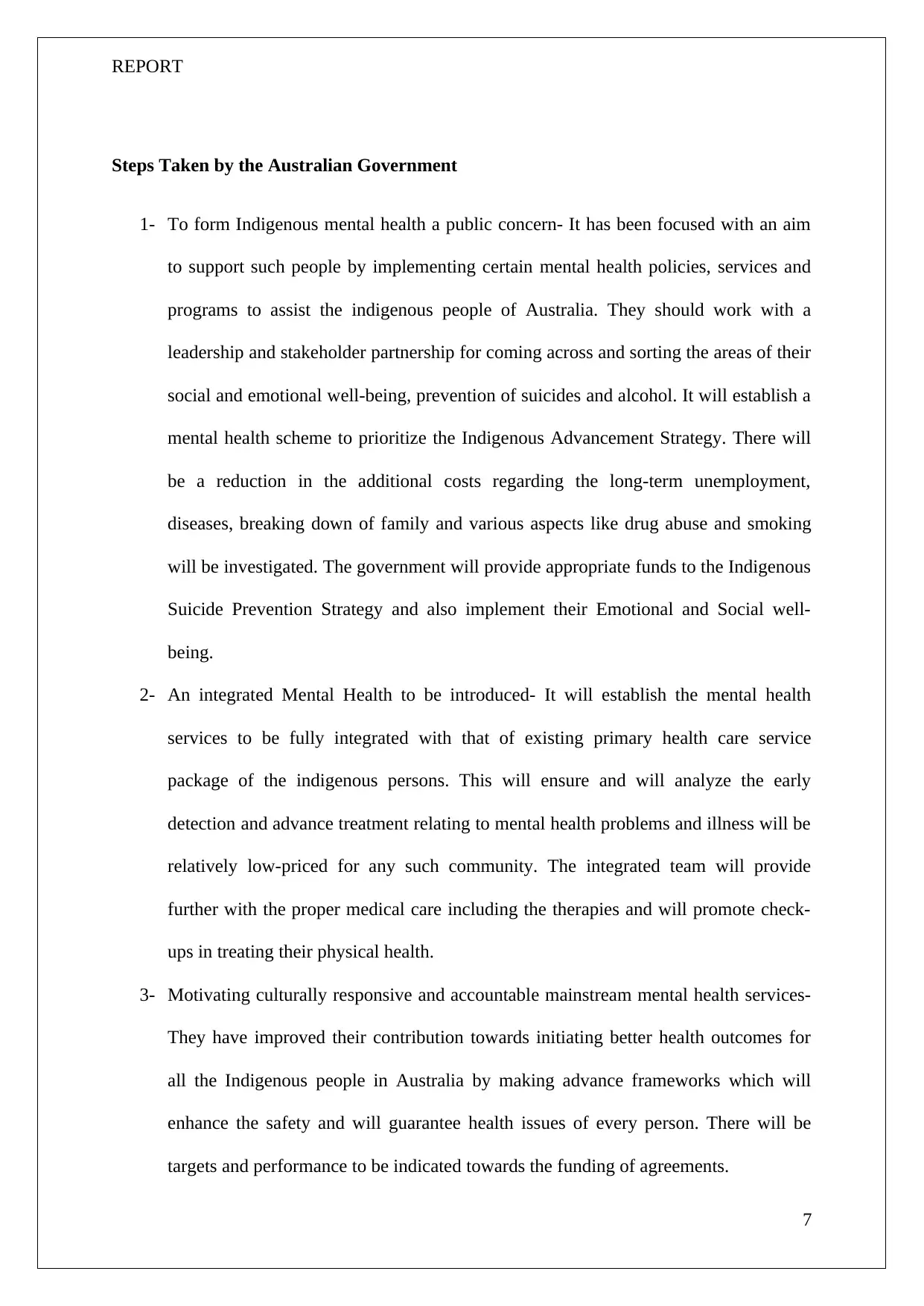
REPORT
Steps Taken by the Australian Government
1- To form Indigenous mental health a public concern- It has been focused with an aim
to support such people by implementing certain mental health policies, services and
programs to assist the indigenous people of Australia. They should work with a
leadership and stakeholder partnership for coming across and sorting the areas of their
social and emotional well-being, prevention of suicides and alcohol. It will establish a
mental health scheme to prioritize the Indigenous Advancement Strategy. There will
be a reduction in the additional costs regarding the long-term unemployment,
diseases, breaking down of family and various aspects like drug abuse and smoking
will be investigated. The government will provide appropriate funds to the Indigenous
Suicide Prevention Strategy and also implement their Emotional and Social well-
being.
2- An integrated Mental Health to be introduced- It will establish the mental health
services to be fully integrated with that of existing primary health care service
package of the indigenous persons. This will ensure and will analyze the early
detection and advance treatment relating to mental health problems and illness will be
relatively low-priced for any such community. The integrated team will provide
further with the proper medical care including the therapies and will promote check-
ups in treating their physical health.
3- Motivating culturally responsive and accountable mainstream mental health services-
They have improved their contribution towards initiating better health outcomes for
all the Indigenous people in Australia by making advance frameworks which will
enhance the safety and will guarantee health issues of every person. There will be
targets and performance to be indicated towards the funding of agreements.
7
Steps Taken by the Australian Government
1- To form Indigenous mental health a public concern- It has been focused with an aim
to support such people by implementing certain mental health policies, services and
programs to assist the indigenous people of Australia. They should work with a
leadership and stakeholder partnership for coming across and sorting the areas of their
social and emotional well-being, prevention of suicides and alcohol. It will establish a
mental health scheme to prioritize the Indigenous Advancement Strategy. There will
be a reduction in the additional costs regarding the long-term unemployment,
diseases, breaking down of family and various aspects like drug abuse and smoking
will be investigated. The government will provide appropriate funds to the Indigenous
Suicide Prevention Strategy and also implement their Emotional and Social well-
being.
2- An integrated Mental Health to be introduced- It will establish the mental health
services to be fully integrated with that of existing primary health care service
package of the indigenous persons. This will ensure and will analyze the early
detection and advance treatment relating to mental health problems and illness will be
relatively low-priced for any such community. The integrated team will provide
further with the proper medical care including the therapies and will promote check-
ups in treating their physical health.
3- Motivating culturally responsive and accountable mainstream mental health services-
They have improved their contribution towards initiating better health outcomes for
all the Indigenous people in Australia by making advance frameworks which will
enhance the safety and will guarantee health issues of every person. There will be
targets and performance to be indicated towards the funding of agreements.
7
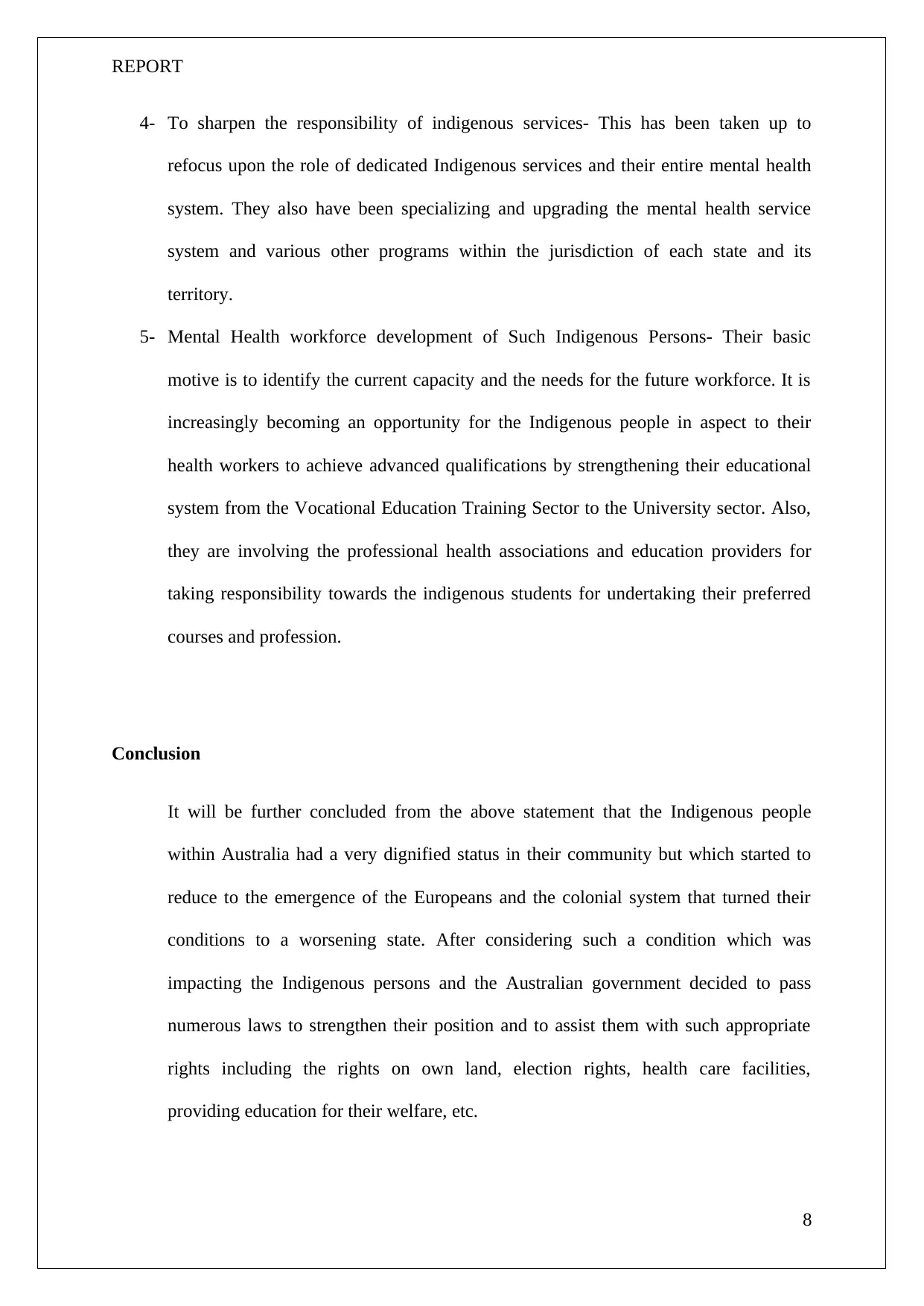
REPORT
4- To sharpen the responsibility of indigenous services- This has been taken up to
refocus upon the role of dedicated Indigenous services and their entire mental health
system. They also have been specializing and upgrading the mental health service
system and various other programs within the jurisdiction of each state and its
territory.
5- Mental Health workforce development of Such Indigenous Persons- Their basic
motive is to identify the current capacity and the needs for the future workforce. It is
increasingly becoming an opportunity for the Indigenous people in aspect to their
health workers to achieve advanced qualifications by strengthening their educational
system from the Vocational Education Training Sector to the University sector. Also,
they are involving the professional health associations and education providers for
taking responsibility towards the indigenous students for undertaking their preferred
courses and profession.
Conclusion
It will be further concluded from the above statement that the Indigenous people
within Australia had a very dignified status in their community but which started to
reduce to the emergence of the Europeans and the colonial system that turned their
conditions to a worsening state. After considering such a condition which was
impacting the Indigenous persons and the Australian government decided to pass
numerous laws to strengthen their position and to assist them with such appropriate
rights including the rights on own land, election rights, health care facilities,
providing education for their welfare, etc.
8
4- To sharpen the responsibility of indigenous services- This has been taken up to
refocus upon the role of dedicated Indigenous services and their entire mental health
system. They also have been specializing and upgrading the mental health service
system and various other programs within the jurisdiction of each state and its
territory.
5- Mental Health workforce development of Such Indigenous Persons- Their basic
motive is to identify the current capacity and the needs for the future workforce. It is
increasingly becoming an opportunity for the Indigenous people in aspect to their
health workers to achieve advanced qualifications by strengthening their educational
system from the Vocational Education Training Sector to the University sector. Also,
they are involving the professional health associations and education providers for
taking responsibility towards the indigenous students for undertaking their preferred
courses and profession.
Conclusion
It will be further concluded from the above statement that the Indigenous people
within Australia had a very dignified status in their community but which started to
reduce to the emergence of the Europeans and the colonial system that turned their
conditions to a worsening state. After considering such a condition which was
impacting the Indigenous persons and the Australian government decided to pass
numerous laws to strengthen their position and to assist them with such appropriate
rights including the rights on own land, election rights, health care facilities,
providing education for their welfare, etc.
8
⊘ This is a preview!⊘
Do you want full access?
Subscribe today to unlock all pages.

Trusted by 1+ million students worldwide
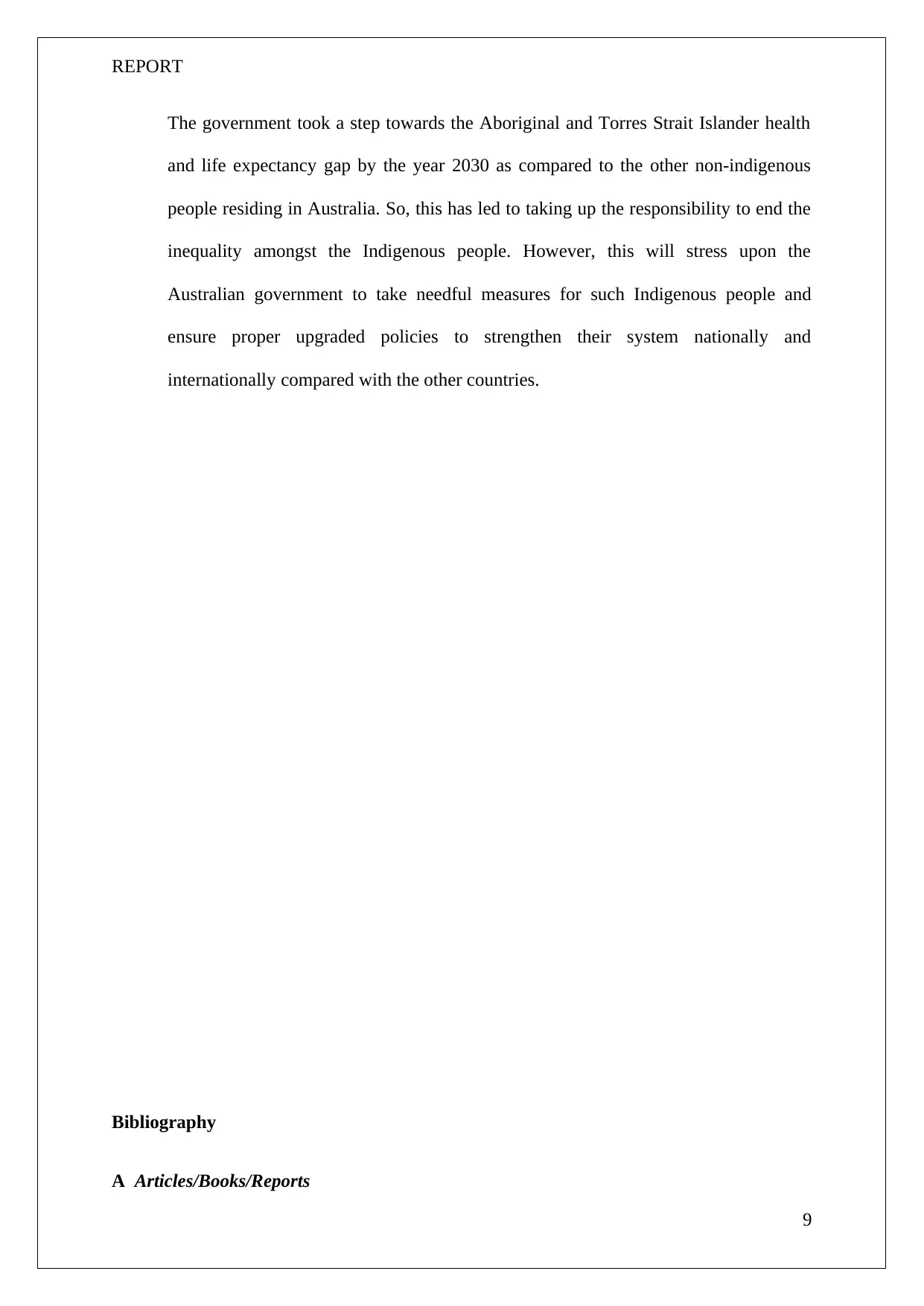
REPORT
The government took a step towards the Aboriginal and Torres Strait Islander health
and life expectancy gap by the year 2030 as compared to the other non-indigenous
people residing in Australia. So, this has led to taking up the responsibility to end the
inequality amongst the Indigenous people. However, this will stress upon the
Australian government to take needful measures for such Indigenous people and
ensure proper upgraded policies to strengthen their system nationally and
internationally compared with the other countries.
Bibliography
A Articles/Books/Reports
9
The government took a step towards the Aboriginal and Torres Strait Islander health
and life expectancy gap by the year 2030 as compared to the other non-indigenous
people residing in Australia. So, this has led to taking up the responsibility to end the
inequality amongst the Indigenous people. However, this will stress upon the
Australian government to take needful measures for such Indigenous people and
ensure proper upgraded policies to strengthen their system nationally and
internationally compared with the other countries.
Bibliography
A Articles/Books/Reports
9
Paraphrase This Document
Need a fresh take? Get an instant paraphrase of this document with our AI Paraphraser
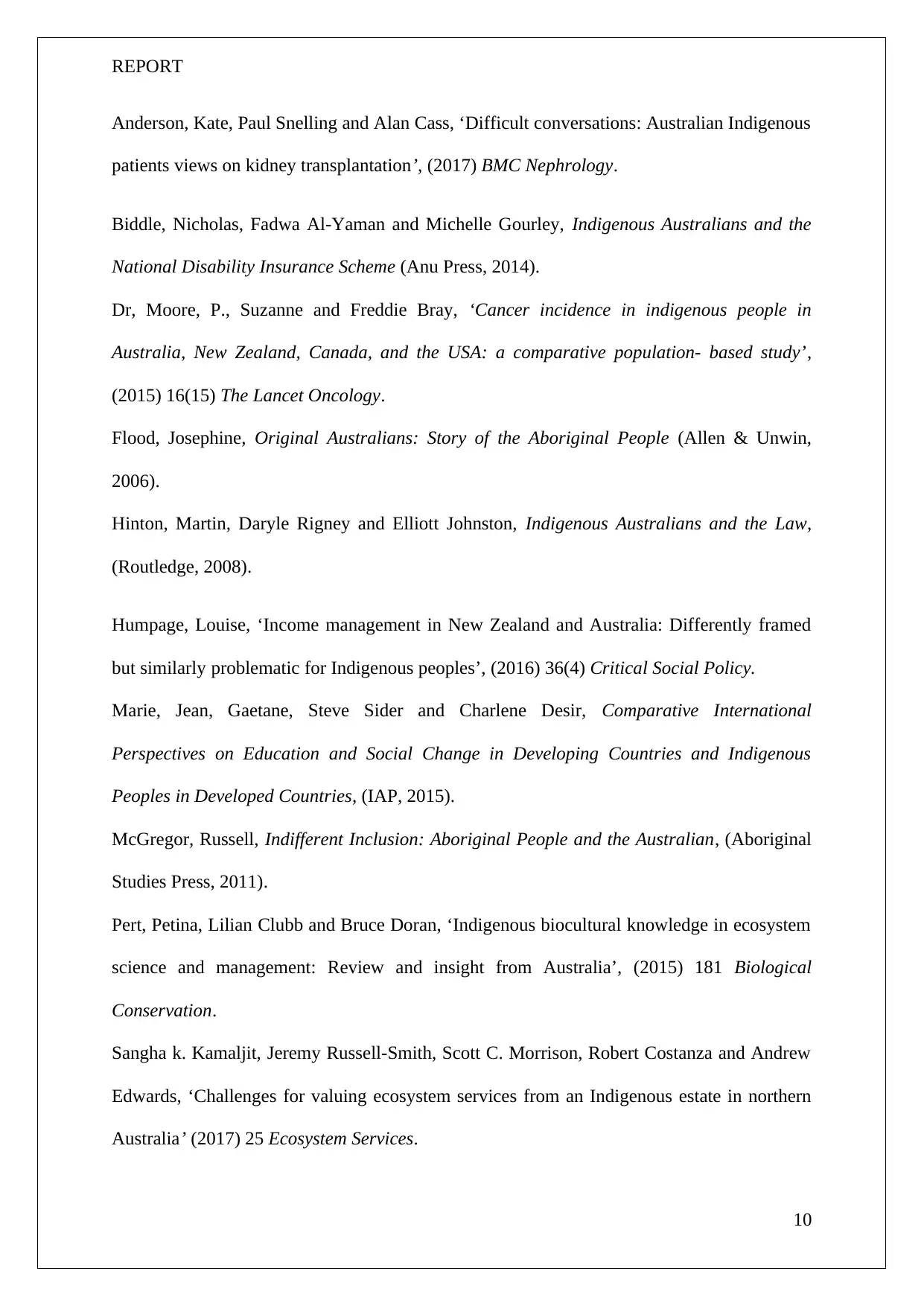
REPORT
Anderson, Kate, Paul Snelling and Alan Cass, ‘Difficult conversations: Australian Indigenous
patients views on kidney transplantation’, (2017) BMC Nephrology.
Biddle, Nicholas, Fadwa Al-Yaman and Michelle Gourley, Indigenous Australians and the
National Disability Insurance Scheme (Anu Press, 2014).
Dr, Moore, P., Suzanne and Freddie Bray, ‘Cancer incidence in indigenous people in
Australia, New Zealand, Canada, and the USA: a comparative population- based study’,
(2015) 16(15) The Lancet Oncology.
Flood, Josephine, Original Australians: Story of the Aboriginal People (Allen & Unwin,
2006).
Hinton, Martin, Daryle Rigney and Elliott Johnston, Indigenous Australians and the Law,
(Routledge, 2008).
Humpage, Louise, ‘Income management in New Zealand and Australia: Differently framed
but similarly problematic for Indigenous peoples’, (2016) 36(4) Critical Social Policy.
Marie, Jean, Gaetane, Steve Sider and Charlene Desir, Comparative International
Perspectives on Education and Social Change in Developing Countries and Indigenous
Peoples in Developed Countries, (IAP, 2015).
McGregor, Russell, Indifferent Inclusion: Aboriginal People and the Australian, (Aboriginal
Studies Press, 2011).
Pert, Petina, Lilian Clubb and Bruce Doran, ‘Indigenous biocultural knowledge in ecosystem
science and management: Review and insight from Australia’, (2015) 181 Biological
Conservation.
Sangha k. Kamaljit, Jeremy Russell-Smith, Scott C. Morrison, Robert Costanza and Andrew
Edwards, ‘Challenges for valuing ecosystem services from an Indigenous estate in northern
Australia’ (2017) 25 Ecosystem Services.
10
Anderson, Kate, Paul Snelling and Alan Cass, ‘Difficult conversations: Australian Indigenous
patients views on kidney transplantation’, (2017) BMC Nephrology.
Biddle, Nicholas, Fadwa Al-Yaman and Michelle Gourley, Indigenous Australians and the
National Disability Insurance Scheme (Anu Press, 2014).
Dr, Moore, P., Suzanne and Freddie Bray, ‘Cancer incidence in indigenous people in
Australia, New Zealand, Canada, and the USA: a comparative population- based study’,
(2015) 16(15) The Lancet Oncology.
Flood, Josephine, Original Australians: Story of the Aboriginal People (Allen & Unwin,
2006).
Hinton, Martin, Daryle Rigney and Elliott Johnston, Indigenous Australians and the Law,
(Routledge, 2008).
Humpage, Louise, ‘Income management in New Zealand and Australia: Differently framed
but similarly problematic for Indigenous peoples’, (2016) 36(4) Critical Social Policy.
Marie, Jean, Gaetane, Steve Sider and Charlene Desir, Comparative International
Perspectives on Education and Social Change in Developing Countries and Indigenous
Peoples in Developed Countries, (IAP, 2015).
McGregor, Russell, Indifferent Inclusion: Aboriginal People and the Australian, (Aboriginal
Studies Press, 2011).
Pert, Petina, Lilian Clubb and Bruce Doran, ‘Indigenous biocultural knowledge in ecosystem
science and management: Review and insight from Australia’, (2015) 181 Biological
Conservation.
Sangha k. Kamaljit, Jeremy Russell-Smith, Scott C. Morrison, Robert Costanza and Andrew
Edwards, ‘Challenges for valuing ecosystem services from an Indigenous estate in northern
Australia’ (2017) 25 Ecosystem Services.
10
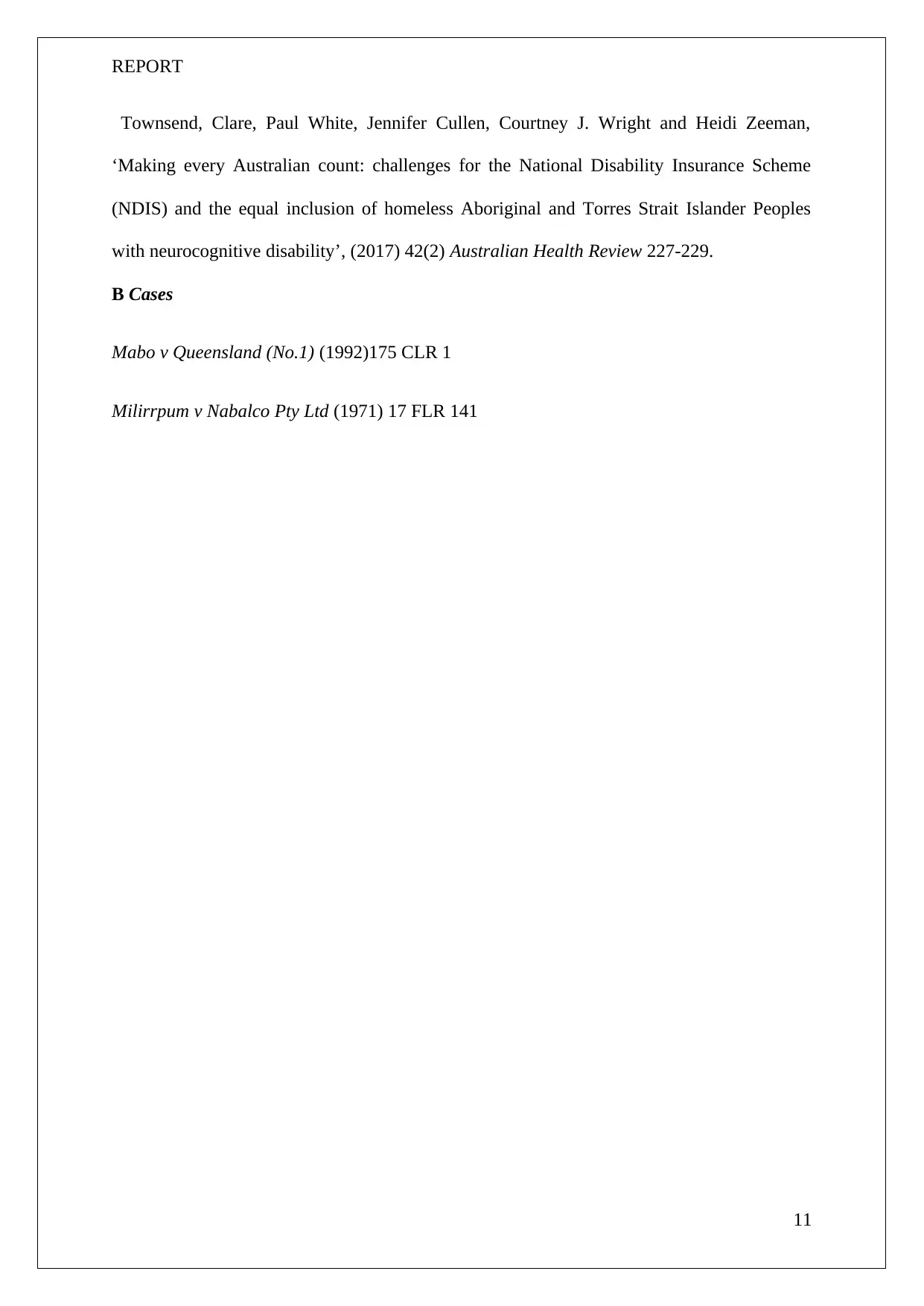
REPORT
Townsend, Clare, Paul White, Jennifer Cullen, Courtney J. Wright and Heidi Zeeman,
‘Making every Australian count: challenges for the National Disability Insurance Scheme
(NDIS) and the equal inclusion of homeless Aboriginal and Torres Strait Islander Peoples
with neurocognitive disability’, (2017) 42(2) Australian Health Review 227-229.
B Cases
Mabo v Queensland (No.1) (1992)175 CLR 1
Milirrpum v Nabalco Pty Ltd (1971) 17 FLR 141
11
Townsend, Clare, Paul White, Jennifer Cullen, Courtney J. Wright and Heidi Zeeman,
‘Making every Australian count: challenges for the National Disability Insurance Scheme
(NDIS) and the equal inclusion of homeless Aboriginal and Torres Strait Islander Peoples
with neurocognitive disability’, (2017) 42(2) Australian Health Review 227-229.
B Cases
Mabo v Queensland (No.1) (1992)175 CLR 1
Milirrpum v Nabalco Pty Ltd (1971) 17 FLR 141
11
⊘ This is a preview!⊘
Do you want full access?
Subscribe today to unlock all pages.

Trusted by 1+ million students worldwide
1 out of 14
Related Documents
Your All-in-One AI-Powered Toolkit for Academic Success.
+13062052269
info@desklib.com
Available 24*7 on WhatsApp / Email
![[object Object]](/_next/static/media/star-bottom.7253800d.svg)
Unlock your academic potential
Copyright © 2020–2025 A2Z Services. All Rights Reserved. Developed and managed by ZUCOL.





